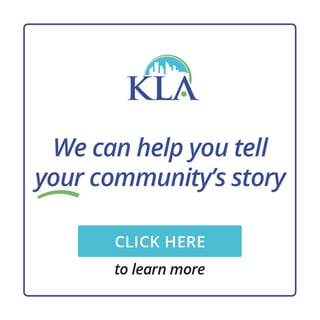3 Unique Ways to Get Your Stakeholders + Community Involved in Emergency Preparedness and Climate Resilience
We’re in the middle of hurricane and wildfire seasons with other parts of the country battling heat waves and others recovering from flooding. And we’re weeks away from National Emergency Preparedness Month (September). Is your community ready if your number is up?
There are plenty of ways to engage community members and key stakeholders in your emergency preparedness and climate resilience planning. We're taking a look at 3 -- a game, a survey tool and virtual reality -- that we think are the most fun and effective.
One of the most common things you hear in the aftermath of a natural disaster or emergency situation is “I never thought it would happen here.” But as more and more communities across the US are experiencing some form of severe weather event, it feels like the “better to be safe than sorry” mantra applies to each one of us -- as individuals and as communities.
 The challenge is how do you get people -- busy with their own lives and day-to-day realities -- to start with a family emergency plan but not to stop there? If you’ve watched any post-disaster TV coverage, you realize how much we each depend on our neighbors and local government and community services and resources. That’s why the notion of “resilience hubs” has gained so much steam. In those dire situations, you’re only as strong as those neighbors and systems, which makes getting broad community engagement and awareness critical.
The challenge is how do you get people -- busy with their own lives and day-to-day realities -- to start with a family emergency plan but not to stop there? If you’ve watched any post-disaster TV coverage, you realize how much we each depend on our neighbors and local government and community services and resources. That’s why the notion of “resilience hubs” has gained so much steam. In those dire situations, you’re only as strong as those neighbors and systems, which makes getting broad community engagement and awareness critical.
What are some of the best practices out there for getting community members and key stakeholders more active in your emergency preparedness and climate resilience planning?
Make it fun. Make it hit home. Give them easy entry points. Here are 3 ways to do just that:
1. Gamify with Game of Floods
We’ve used Game of Floods, an award-winning engagement tool developed in California, with our client Columbia, MO, and Indianapolis, IN. This is a truly unique and constructive way to engage members of your community who don’t want to come listen to a panel of experts while their eyes glaze over at powerpoint presentations.
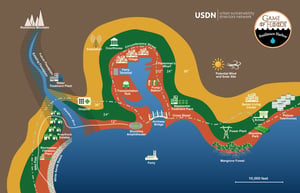 The Game of Floods is a resource-management game in many aspects similar to the Settlers of Catan. Players play on the playing board with hexagonal flood zones. They manage community assets, which could be flooded at any moment. Players strategize on how to protect their chosen parcels constantly worrying about community well-being and resources. They have to consider the potential loss or deterioration of homes, community facilities, roads, agricultural land, beaches, wetlands, lagoons, and other resources.
The Game of Floods is a resource-management game in many aspects similar to the Settlers of Catan. Players play on the playing board with hexagonal flood zones. They manage community assets, which could be flooded at any moment. Players strategize on how to protect their chosen parcels constantly worrying about community well-being and resources. They have to consider the potential loss or deterioration of homes, community facilities, roads, agricultural land, beaches, wetlands, lagoons, and other resources.
Listen to a short overview from Yale Climate Connections.
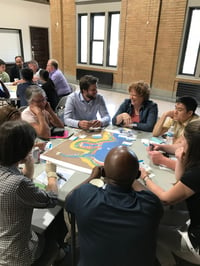 In Columbia and Indianapolis, the Urban Sustainability Directors Network ran the Game of Floods exercise -- something they offer to all USDN members. The USDN version has multiple roles for participants, including wastewater treatment operator, economic development director, mayor, and mangrove protection activist. In Indianapolis we used as part of the Multi-Hazard Mitigation Plan public workshop, giving people experience thinking through scenarios and making tough decisions prior to providing feedback on the plan. Columbia used it with their staff as they move forward on climate action and adaptation plan.
In Columbia and Indianapolis, the Urban Sustainability Directors Network ran the Game of Floods exercise -- something they offer to all USDN members. The USDN version has multiple roles for participants, including wastewater treatment operator, economic development director, mayor, and mangrove protection activist. In Indianapolis we used as part of the Multi-Hazard Mitigation Plan public workshop, giving people experience thinking through scenarios and making tough decisions prior to providing feedback on the plan. Columbia used it with their staff as they move forward on climate action and adaptation plan.
This would be a great resource for youth and school outreach, too!
2. Give everyone easy access.
When it comes to community engagement for a planning process or other city initiative, many local governments struggle to get the quantity and quality of feedback that truly reflects the population in numbers or diversity.
KLA recently partnered with MetroQuest to help our clients jump that hurdle.
This can have direct implications for a city shaping a resilience or hazard mitigation plan. Take Indianapolis, where KLA is leading the city’s effort to develop their first comprehensive sustainability and resilience action plan. The plan encompasses eight elements: Built Environment; Economy; Energy; Food & Urban Agriculture; Natural Resources; Public Health & Safety; Transportation & Land Use; and Waste & Recycling. And the City wants to get substantive feedback on each of those areas from a diverse and robust chunk of the population.
Through local partners we’re handling some of the targeted outreach -- homeless, veterans, seniors, etc -- especially those with limited internet access. But our customized MetroQuest site is allowing us to hit the numbers goal of the equation.
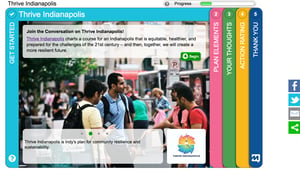 With MetroQuest, the City of Indianapolis is able to reach its large (just under 900,000), very spread out (more than 400 square miles) population with an interactive platform that gives them the opportunity to rate potential actions, indicate to what degree they agree or disagree with a statement, and drag and drop coins between projects to indicate which they think should be funded. MetroQuest has a history of getting record numbers of engagement, and we are hoping to see the same results in Indianapolis by promoting through social media, events, and the project website.
With MetroQuest, the City of Indianapolis is able to reach its large (just under 900,000), very spread out (more than 400 square miles) population with an interactive platform that gives them the opportunity to rate potential actions, indicate to what degree they agree or disagree with a statement, and drag and drop coins between projects to indicate which they think should be funded. MetroQuest has a history of getting record numbers of engagement, and we are hoping to see the same results in Indianapolis by promoting through social media, events, and the project website.
3. Get “IMMERSED” with virtual reality
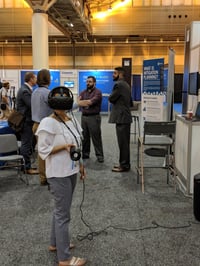 Several of KLA’s team members had the opportunity to experience FEMA’s new IMMERSED virtual reality tool at the APA National Planning Conference last spring.
Several of KLA’s team members had the opportunity to experience FEMA’s new IMMERSED virtual reality tool at the APA National Planning Conference last spring.
Here is how FEMA describes it:
“To help educate community leaders about the value of preparing for the worst, FEMA has created a virtual reality experience called IMMERSED. This tool puts users at the center of a flood crisis, allowing them to assess damage in a community and see the benefits of mitigation first-hand. Through simple tasks, users experience a major flood event in a real, personal way. From the perspective of a community leader in a flood-affected town, they:
- Explore the damage in a flooded neighborhood
- Witness the challenges of an evacuation
- Lead a stranded teacher to safety at a flooded school
- Experience mitigation decisions being made
- Discover which preparations can lead to positive results
After users experience IMMERSED, they are encouraged to explore additional information about mitigation action, including
- Descriptions of and specifications for the different types of action
- Details on grants and other programs that are available to support communities in taking action
- Information about a variety of related topics, including the National Flood Insurance Program, hazard mitigation planning and community engagement.”
In our experience, this could have a huge impact on elected officials and other stakeholders in areas where flooding poses a potential threat -- especially with climate change impacts like sea level rise and more intense storms.
One of the challenges is that the VR experience itself right now isn’t something you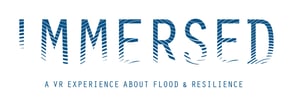 can just download on the App Store and load up on any VR headset. But word on the street is that FEMA is working on that, including a scenario more geared toward homeowners which would up the community engagement value. Eventually as IMMERSED or a new iteration becomes more mobile, the agency could send a certain number out to each region which would allow local and state governments to check it out. In the meantime, you can contact FEMA to inquire about bringing the experience to an upcoming local government or stakeholder meeting.
can just download on the App Store and load up on any VR headset. But word on the street is that FEMA is working on that, including a scenario more geared toward homeowners which would up the community engagement value. Eventually as IMMERSED or a new iteration becomes more mobile, the agency could send a certain number out to each region which would allow local and state governments to check it out. In the meantime, you can contact FEMA to inquire about bringing the experience to an upcoming local government or stakeholder meeting.
The National Emergency Management Association held a webinar on IMMERSED last fall which you can watch online.
There are plenty of opportunities to freshen up your approach to community engagement, especially when it comes to the important task of emergency preparedness at the community level. We’ve seen these three in action and will share other resources and strategies as we come across them.
If you'd like to talk with KLA about how we can bring these and other unique solutions to your community, set up a time to chat (click the link below to schedule) or drop us a line.




